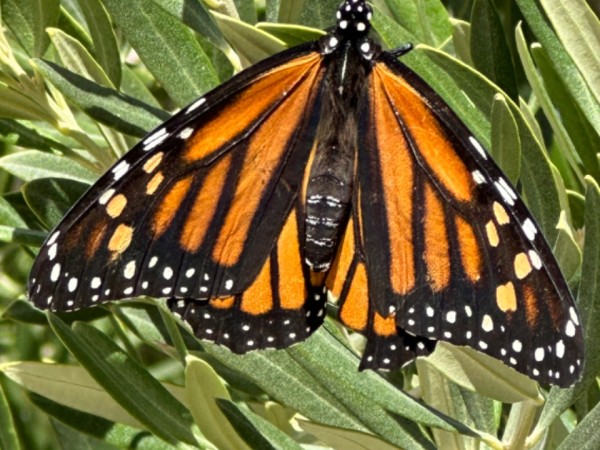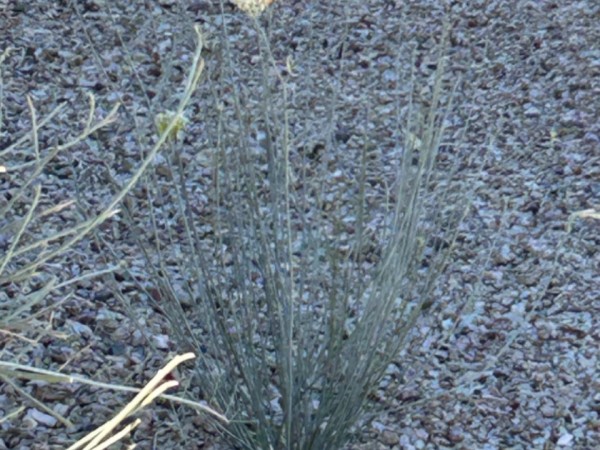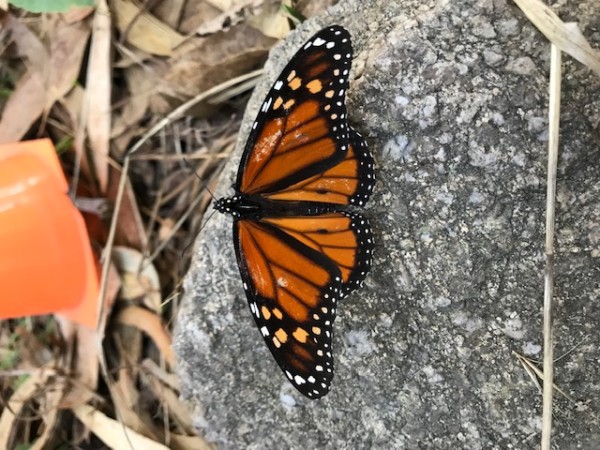Letter From Gail Morris: Western Monarch Fall 2023 Report #6
Changing Season
Cooler air and a series of winter low-pressure systems are approaching the California coast signaling a change in the seasonal weather. Monarchs are settling into groves along the coast as volunteers begin the annual Thanksgiving Counts to compare the number of this year’s successful migrators to earlier years. So far, the early numbers of the monarch overwintering population appear lower than in recent years. After last winter’s intense storms during the spring dispersal to the breeding grounds, we are hopeful that the numbers will improve. Soon monarchs across the West will lose their urge to migrate, but there will still be limited movement up and down the coast.
Recent Sightings
Here is a sample of new sightings reported recently since the beginning of November. Be sure to see the higher density of monarch sightings on the Journey North map.
Jennifer in Las Vegas, Nevada, reported one monarch on November 3. “Very active adult visiting our 5 Asclepius and nectaring on those flowers and Tecomaria capensis flowers. No evidence of eggs yet.”
In Baywood-Los Asos, California, Jane found one monarch on December 9. “Monarch flying around garden.”
Betty in Queen Creek, Arizona, saw a bright orange butterfly on her Desert (Rush) Milkweed.
On November 14, Susan in El Segundo, California spotted two monarchs. “2 flying Monarch butterflies high by the tall pine trees at 10 am on a warm, sunny day.”
Reports from the Field
Pacific Grove, California
News from Stephanie Turcotte at Pacific Grove, California:
“My fingers are still numb from a 2hr+ count at 46 degrees! Our numbers are higher than last week’s, although not higher by leaps and bounds. We counted 7,604 monarchs across 13 trees varying still in species between Monterey pines, Monterey cypress, and Eucalyptus. The majority continue to cluster on the Monterey pine dubbed ‘Nexus’, which overhangs the footpath. There are 4,970 on that tree, with clusters on pines and cypress to the east and west of ’Nexus'. They are still south-facing there and are not clustering on the north-facing sides of those trees, yet; nor are they in the interior of the habitat.
“The challenge with the monarchs hanging on branches overhanging the footpath is that when some of them fly off, the microclimates in the grove are so varied that the monarchs quickly encounter cold air pockets and end up on the ground where visitors don’t see them. Most people look up and don’t look down. So please encourage anyone you send to visit the Pacific Grove habitat, especially, to please be mindful of how they walk through.
“There are still monarchs loosely clustered in the southern end of the grove hanging on Eucalyptus branches which get some of the early sun. The petite Monterey pine in the neighbor’s yard has 494, about half of what it had last week. Additionally, for the record….11/11/22 we counted 12,631 and 11/13/21 we counted 13,431.
“We are set to get rain in our area next week. It is supposed to begin raining today, Wednesday, and rain through Saturday, in varying degrees. I was in the grove yesterday and there was a significant difference in terms of numbers on the trees (Monterey pines and cypress) along the path where the majority were last Friday when we counted. Either they have moved deeper inside the habitat, or they are on the back side of the Eucalyptus trees along the neighbor’s fence. At least I am hoping they are somewhere where we can’t see them. There were some large clusters back on one of the baby Eucalyptus trees, on the south side, despite the impending weather. I was there with an early field trip and watched several monarchs, as they moved from that tree to the trees across the path once the temperature enabled them to do so. We are scheduled to count on Saturday; however, the rain may delay that until Sunday. The monarchs and the plants that sustain them need the rain. Stay tuned…"
Santa Cruz, California
Diana Magor shares her monitoring reports at these two important sights in Santa Cruz, California.
“Monarchs counted today at Lighthouse Field, Santa Cruz: 7,080 Cold mornings (mid to high 40’s) and warm, sunny days (high 60s to low 70s) have prevailed this week. Rain is expected next week. The vast majority are inside the grove on Monterey Cypress. Only 29 were observed on Eucalyptus.
“Estimates from others for Natural Bridges on Oct 30 were 5,300. For Moran Lake on 10/31 about 2,300. They’re probably higher at both locations by now.
“I believe the Thanksgiving count for Santa Cruz County is next weekend Fri and Sat (Nov 17, 18).”
Thank You!
A special Thank You to Stephanie Turcotte and Diana Magor for their reports. We will be waiting to see the monarch numbers with the annual Thanksgiving Count in progress in the next few weeks.
Keep your eyes on the sky looking for monarchs as they reach the final stages of their fall journey. If you are out this week and see monarchs of any life stage, be sure to report them to Journey North—whether they are adults, eggs, or larvae. Provide as much information as you can such as weather conditions (it’s okay to estimate). Your detailed description of what you see can include, but is not limited to, the monarch’s gender and activity and if known, the type of flowers if they are nectaring.
Gail Morris is the Coordinator of the Southwest Monarch Study (www.swmonarchs.org), a Monarch Watch Conservation Specialist, and the Vice President of the Monarch Butterfly Fund, the Central Arizona Butterfly Association, and the Western Monarch Advocates. The Western Monarch Population News is based on comments provided to Gail Morris. We hope to increase the number of sightings and therefore photos and comments entered into the Journey North. We rely on the volunteers who communicate regularly with Gail and who agree to participate in our effort to increase awareness of the population of Western Monarchs. You can reach her at gail@swmonarchs.org




